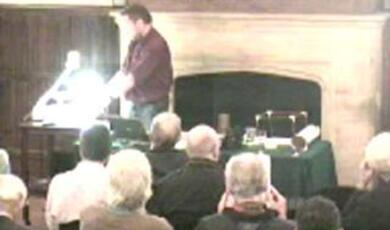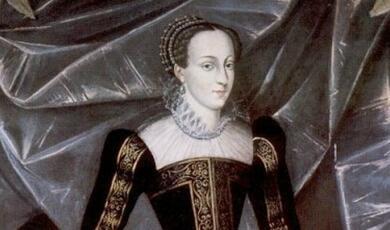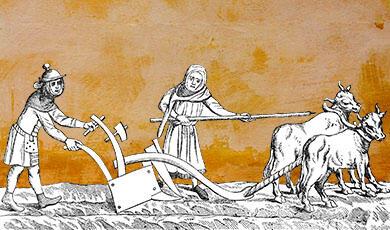Euler - 300th anniversary lecture
Share
- Details
- Transcript
- Audio
- Downloads
- Extra Reading
Leönhard Euler (born 15 April 1707), the 'Mozart of mathematics', was probably the most prolific mathematician of all time. He contributed to many areas, both theoretical and practical, yet remains largely unknown except to mathematicians. Who was he, what did he do, and why do mathematicians regard him so highly?
Download Transcript
EULER - 300th ANNIVERSARY LECTURE
Robin Wilson
Leonhard Euler was the most prolific mathematician of all time. He wrote more than 500 books and papers during his lifetime - about 800 pages per year - with an incredible 400 further publications appearing posthumously. His collected works and correspondence are still not completely published: they already fill over seventy large volumes, comprising tens of thousands of pages.
Euler worked in an astonishing variety of areas, ranging from the very pure - the theory of numbers, the geometry of a circle and musical harmony - via such areas as infinite series, logarithms, the calculus and mechanics, to the practical - optics, astronomy, the motion of the Moon, the sailing of ships, and much else besides. Indeed, Euler originated so many ideas that his successors have been kept busy trying to follow them up ever since; indeed, to Pierre-Simon Laplace, the French applied mathematician, is attributed the exhortation in the title of this article.
Not surprisingly, many concepts are named after him: Euler's constant, Euler's polyhedron formula, the Euler line of a triangle, Euler's equations of motion, Eulerian graphs, Euler's pentagonal formula for partitions, and many others.
Euler's life can be divided into four periods. He was born in Basel, Switzerland, on 15 April 1707, where he grew up and went to university. At the age of 20 he went to Russia, to the St Petersburg Academy, where he became head of the mathematics division. Things eventually got so bad there that he went to Berlin in 1741, where he stayed for twenty-five years. Things then got bad there (but for different reasons), and he returned to St Petersburg in 1766 where he spent the rest of his life, eventually dying in 1783.
Basel
Leonhard Euler's father was a Calvinist pastor of modest means who wished his son to follow him into the ministry. On entering the University of Basel at the age of 14, not an unusual age in those days, the young Euler duly studied theology and Hebrew, law and philosophy.
While at the University, he encountered Johann Bernoulli, possibly the finest mathematician of his day, who was impressed with Euler's mathematical abilities and agreed to give him private teaching every Saturday, quickly realising that his pupil was something out of the ordinary. Euler also became close friends with Johann's sons, Daniel and Nicholas, although Nicholas was to die soon after.
Euler took his Master's degree in 1724, at the age of 17, and entered divinity school to train for the ministry:
I had to register in the faculty of theology, and I was to apply myself to the Greek and Hebrew languages, but not much progress was made, for I turned most of my time to mathematical studies, and by my happy fortune the Saturday visits to Johann Bernoulli continued.
Eventually, Bernoulli persuaded Euler's reluctant father that his talented son was destined to become a great mathematician, and Euler left the ministry.
His first significant mathematical achievement occurred when he was just twenty. The Paris Academy had proposed a prize problem involving the placing of masts on a sailing ship, and Euler's memoir, while not gaining the prize, received an honourable mention. Later, Euler actually won the prize - twelve times!
Euler next applied for the Chair of Mathematics at the University of Basel. He didn't get it, but meanwhile Daniel Bernoulli had taken up a position at the St Petersburg Academy in Russia, and invited Euler to join him there. The only available position was in medicine and physiology, but jobs were scarce - so Euler learned these subjects, in the process of which his study of the ear led him to investigate the mathematics of sound and the propagation of waves.
St Petersburg
In the event, fate dealt a cruel blow. On the very day that Euler arrived in Russia, the liberal Empress Catherine I, who had set up the Academy, died. Her heir was still a boy, and the faction that ruled in his place regarded the Academy as something of a luxury. Euler kept his head down and got on with his work, while living at the home of Daniel Bernoulli and working closely with him. By this time Euler was working in physics, rather than in medicine.
In 1733, Daniel Bernoulli had had enough of the problems of the Academy and returned to an academic post in Switzerland, while Euler, still aged only 26, replaced him in the Chair of Mathematics. He determined to make the best of a difficult situation and settle down, so he got married and had thirteen children, although only five survived to adolescence. Euler apparently enjoyed having his children around him, and even managed to carry out mathematical researches with a baby on his lap!
The 1730s were indeed very productive years, with substantial advances in number theory, the summation of series and mechanics. At the same time he was acting as a scientific consultant to the government - preparing maps, advising the Russian navy, testing designs for fire engines, and writing textbooks for the Russian schools - although he apparently drew the line when he was asked to cast a horoscope for the young Czar.
An area to which Euler contributed throughout his life was the theory of numbers. In December 1729, he received a letter from his colleagueChristian Goldbach, who is best remembered for the still-unprovedGoldbach conjecture, which states that every even number can be written as the sum of two prime numbers: for example,
20 = 13 + 7 or 30 = 11 + 19.
Goldbach's letter was concerned with the Fermat primes, those of the form
22n + 1
For example, for n = 0, 1, 2, 3 and 4 we obtain the prime numbers 3, 5, 17, 257 and 65537. Are all such numbers primes' Pierre de Fermat had conjectured that they are, but Euler showed that the next one (232 + 1), a ten-digit number, is actually divisible by 641. Since then, no otherFermat number has been shown to be prime, so Fermat's conjecture was an unfortunate one.
Euler's prodigious calculating abilities soon became legendary. One day, two students were trying to sum a complicated progression and disagreed over the 50th decimal place. Euler simply calculated the correct value in his head. Such achievements led the French physicist François Arago to exclaim:
He calculated without any apparent effort, just as men breathe, as eagles sustain themselves in the air.
Another challenge given to Euler was to find four different numbers, the sum of any two of which is a perfect square. Euler produced the quartet: 18530, 38114, 45986 and 65570.
A different preoccupation in the 1730s was his work on infinite series. For example, he became interested in the harmonic series
1 + 1/2 + 1/3 + 1/4 + 1/5 + ...,
which does not converge to a finite sum. However, if we look at the first nterms of this series, then their sum turns out to be close to log n - in fact, as Euler proved in the 1730s, as n becomes large, the difference between the sum of the first n terms and log n gets closer and closer to a fixed number - a strange number now called Euler's constant. Its value is about 0.5772... , but no-one knows much about it - we do not even know whether it's a rational number.
One other puzzle, known as the Basel problem, exercised many minds at the time. It was to find the exact sum of the series
1 + 1/4 + 1/9 + 1/16 + 1/25 + ...,
involving the reciprocals of the perfect squares. One of Euler's earliest achievements was to show that the sum of this series is ?2/6. He then extended his calculations to find the sum of the reciprocals of all the 4th powers, 6th powers, and so on, right up to the 26th power. This led him to define what we now call the Riemann zeta function.
As light relief from all these calculations, we next look at a recreational puzzle that Euler solved in 1735: the problem of the bridges of Königsberg. The medieval city of Königsberg consisted of four areas of land linked by seven bridges, and the problem was to cross each bridge just once, and return to one's starting point. Euler employed a counting argument, counting the number of bridges emerging from each land area, and proved that this cannot be done.
Euler considered the bridges problem in the context of a query by Leibnizwho, in a letter to Christiaan Huygens in 1679, had asked for a type of geometry that involves no metrical ideas such as length, distance or angle. We now call this topology, or rubber-sheet geometry - the problem remains the same if we draw the map on rubber and stretch it.
In 1736 Euler wrote a letter to Giovanni Marinoni, Court Astronomer in Vienna, describing what he thought of the problem: "This question is so banal, but seemed to me worthy of attention in that neither geometry, nor algebra, nor even the art of counting was sufficient to solve it. In view of this, it occurred to me to wonder whether it belonged to the geometry of position, which Leibniz had once so much longed for. And so, after some deliberation, I obtained a simple, yet completely established, rule with whose help one can immediately decide for all examples of this kind whether such a round trip is possible."
Euler's solution of the Königsberg bridges problem is considered as the earliest contribution to graph theory, and is now solved by looking at a network with points representing the land areas and lines representing the bridges. But Euler never did this - the network that represents this puzzle was not drawn for 150 years.
In the same year, 1736, Euler published Mechanica, his first treatise on the dynamics of a particle. However, his most important work in this area came later, in 1750, with his work on the motion of rigid bodies - free, or rotating about a point. By choosing the point as the origin of coordinates, and with axes aligned along the principal axes of inertia of the body, he obtained what we now call Euler's equations of motion; the concept ofmoment of inertia is also due to Euler. Even later, in 1776, he proved that any rotation of a rigid body about a point is equivalent to a rotation about a line through that point. Much of this work used differential equations - equations that involved the latest developments in the differential calculus, and an area to which Euler contributed a great deal.
It was around this time, in the late 1730s, that Euler went blind in his right eye. Although he attributed it to overwork, possibly for some close work he had been doing on cartography, it may have been due to an eye infection. However, this did not diminish his productivity: he continued to write on acoustics, musical harmony, ship-building, prime numbers, and much more besides.
Berlin
In 1741, with his fame preceding him, Euler received an invitation from Prussia's Frederick the Great to join the newly vitalised Berlin Academy. With the political situation in Russia still uncertain, he accepted it and stayed in Berlin for 25 years.
At first, Euler got on well with Frederick, even bringing him strawberries from his garden. But later, especially after the seven years war between Germany and Russia, things began to cool as Frederick started to take more and more interest in the workings of the Academy. Being sophisticated, cultured and witty - at least, he thought so - he considered Euler rather a country bumpkin. In return, Euler found Frederick pretentious, not to say petty and rude - Frederick even referred to him as "my cyclops". The story is also told that Euler was once reproached by the Queen of Prussia, Frederick's mother, for not conversing. "Madame", he replied, "I come from a country where, if you speak, you are hanged". The queen was not amused.
Even so, Euler still managed to work on a dazzling range of topics, writing works in the 1740s and 1750s on the theory of tides, the motion of the moon, hydrodynamics (the flow of a river), and the wave motion of vibrating strings.
His most important work at this time was the Introductio in Analysin Infinitorum ("Introduction to the analysis of the infinite"), published in 1748. It was here that he presented some of his earlier work on the number e = 2.71828, defined as the infinite sum
1 + 1/1! + 1/2! + 1/3! + ... or as limn®¥(1 + 1/n)n.
and the related exponential function ex. (Here n! means the product of nand all the positive integers smaller than it, in other words n! = n×(n-1)×(n-2)×... ×1.)
In the 1748 Introductio in Analysin Infinitorum, Euler expressed certain well-known functions as infinite series. He believed that every function, such as sin x, can be expanded in powers of x. Indeed, Newton, Leibniz and others had already been familiar with such expansions as:
(1 - x)-1
=
1 + x + x2 + x3 + x4 + ... ,
(1 - x)-2
=
1 + 2x + 3x2 + 4x3 + 5x4 ... ,
and trigonometric results such as:
sin x
=
x- x3/3! + x5/5! - x7/7! + ... ,
cos x
=
1 - x2/2! + x4/4! - x6/6! + ... .
Euler then introduced one of the greatest masterstrokes in the whole of mathematics. At first, the trigonometrical functions sine and cosine would seem to have nothing in common with the exponential function ex, but if we introduce the complex number i, and play around with the power series, we deduce the fundamental formula linking them,
eix = cos x + i sin x,
from which we deduce, on putting x = ?, that ei? + 1 = 0, an equation that includes the five great constants of mathematics.
There were many other interesting things in the Introductio. Over the 100 years since Descartes there had been a gradual swing from geometry towards algebra, and this reached its climax when Euler actually defined the conic sections (the ellipse, parabola and hyperbola), not as sections of a cone, but in terms of their algebraic equations. Starting with the equation
y2 = a+ bx + gx2,
he showed that we get an ellipse if g is negative, a parabola if g = 0, and a hyperbola if g is positive. He then extended the whole argument to three dimensions, to quadrics, which come in seven types, and studied them algebraically, discovering the hyperbolic paraboloid in the process.
Yet another interesting topic in the Introductio is partitions, or "divulsions of integers", as Leibniz called them when he introduced them in a letter to Bernoulli. In how many ways can we split up a positive integer into a sum of smaller ones?
Let p(n) be the number of partitions of n - for example, p(4) = 5, corresponding to the five partitions
4, 3 + 1, 2 + 2, 2 + 1 + 1 and 1 + 1 + 1 + 1
(the order doesn't matter). So we can draw up a table of values - but how would you show that p(200) has the value 3,972,999,029,388
To find the value of p(n), we use Euler's pentagonal number formula, which he obtained in the Introductio and which yields p(n) by iteration:
p(n) = p(n- 1) + p(n- 2) - p(n- 5) - p(n- 7) + p(n- 12) + ... .
Even now, this is still the most efficient way of finding p(n).
A particularly nice result on partitions, also in the Introductio, concerns odd and distinct partitions. In an odd partition all the separate terms are odd: for example, 9 has eight odd partitions:
9, 7 + 1 + 1, 5 + 3 + 1, 5 + 1 + 1 + 1 + 1, 3 + 3 + 3, 3 + 3 + 1 + 1 + 1,
3 + 1 + 1 + 1 + 1 + 1 + 1 and 1 + 1 + 1 + 1 + 1 + 1 + 1 + 1 + 1 + 1.
In a distinct partition all the terms are different: for example, the number 9 has eight distinct partitions:
9, 8 + 1, 7 + 2, 6 + 3, 6 + 2 + 1, 5 + 4, 5 + 3 + 1 and 4 + 3 + 2.
Using generating functions, Euler proved that for any number, the number of odd partitions is the same as the number of distinct partitions - an intriguing and highly unexpected result.
Another preoccupation of Euler's at the time was mentioned in a letter to Goldbach in 1750. Euler had been looking at polyhedra, such as a cube or a prism, and observed that the numbers of vertices (corners), edges and faces are always related by the formula:
(no. of faces) + (no. of vertices) = (no. of edges) + 2.
For example, the cube has 6 faces, 8 vertices and 12 edges and
6 + 8 = 12 + 2, and similarly for any other solid bounded by plane faces. This formula has been incorrectly credited to Descartes, who did not have the terminology or motivation to derive it: indeed, it was Euler who introduced the concept of an edge. However, Euler's proof was deficient - a complete proof was given 40 years later by the algebraist and number-theorist Legendre.
Euler's most popular and best-selling book was his Letters to a German Princess. Euler was always an extremely clear writer, and this was a multi-volume masterpiece of exposition that he produced when he was asked to give elementary science lessons to the Princess of Anhalt-Dessau. The resulting collection had over 200 "letters" that Euler wrote on a range of scientific topics, including gravity, astronomy, light, sound, magnetism, logic, and much else besides. He wrote about why the sky is blue, why the moon looks larger when it rises, why the tops of mountains are cold (even in the tropics), and also the "electrisation of men and animals", whatever that was. It was one of the best books ever written on popular science.
The last of Euler's Berlin books was his 1755 massive tome on the differential calculus. This contained all the latest results, many due to him, and presented the calculus in terms of the basic idea of a function - indeed, it was Euler who introduced the notation f for a function. Other notations he introduced were - (for summation), i (the square root of -1) and e (the exponential number). He also popularised the notation for -although that was actually introduced by William Jones in 1706. He followed his book on differentiation in 1768 to 1770 with a three-volume treatise on the integral calculus.
St Petersburg revisited
After all his difficulties with Frederick the Great, Euler must have felt very relieved when in 1766, at the age of 59, he received an invitation from Catherine the Great to return to St Petersburg. Things there had improved greatly, thanks to the enlightened Empress, and he was received royally. He continued to work enthusiastically, soon producing a delightful result on pure geometry. In any triangle there are three particular points of interest. The first is the orthocentre - the meeting point of the perpendiculars from the vertices to the opposite sides. Next is the centroid - the meeting point of the three lines joining a vertex to the midpoint of the opposite site. The third is the circumcentre - the centre of the circle surrounding the triangle. By calculating all the coordinates Euler proved the pretty result that these three points always lie in a straight line - now called the Euler line of the triangle - and that the centroid always lies exactly one-third of the distance between the other two.
Euler's life-long interest in number theory continued into his later life, when he extended some results associated with Fermat - in particular,Fermat's last theorem. We all know that there are positive numbers a, b,c satisfying
a2 + b2 = c2.
For example,
32 + 42 = 52, or 52 + 122 = 132.
But Fermat had conjectured in the margin of his copy of Diophantus'sAlgebra that, for any power n greater than 2, there are no positive numbers a, b, c satisfying an + bn = cn. In his number theory book of 1770, Euler proved that the sum of two cubes cannot equal another cube (n = 3), and the sum of two fourth powers cannot equal another fourth power (n = 4). The full version of the theorem as conjectured by Fermat was not proven until 1995.
Another connection with Fermat was Fermat's little theorem, which states that, if a is any number that is not divisible by a given prime number p, then ap-1- 1 must be divisible by p; for example, taking p = 29 and a = 48, we deduce that 4828- 1 is divisible by 29. In 1760 Euler extended this result to numbers other than primes, introducing the Euler -function and proving that, for any numbers a and n, af(n)- 1 is always divisible by n.
Yet another result in number theory concerned perfect numbers - numbers whose proper divisors add up to the number itself. For example, 6 is a perfect number, because its proper divisors are 1, 2 and 3, which sum to 6; similarly, 28 is a perfect number, because it's the sum of 1, 2, 4, 7 and 14. In his Elements, Euclid had proved that every number of the form 2n-1 ×(2n- 1) is perfect, as long as this second term 2n- 1 is a prime. Euler proved that all even perfect numbers have this form - but it is still not known whether any odd perfect numbers exist.
The last few years of Euler's life, though more peaceful than his earlier ones, were full of personal tragedies. In 1771 his house burned down, with the loss of his library, and almost his life, but fortunately his manuscripts were saved. Shortly after this, his beloved wife died and he remarried. And finally he lost most of the sight in his other eye - but again, his productivity remained undiminished as he wrote on slates with his two sons as amenuenses.
In a book on recreational mathematics in 1725, Jacques Ozanam showed how to lay out the sixteen court cards so that each row and column contains each suit and each value, J, Q, K, A. It is also possible to make a similar arrangement with 25 cards - five suits and five values. But what about 36 cards? In the year before he died, in a paper mainly on magic squares (another interest of his), Euler posed this as the 36 officers problem:
Arrange 36 officers, one each of 6 ranks from 6 regiments, in a square array so that each row or column has one officer of each rank and one officer of each regiment.
Euler believed that this cannot be done, and this was eventually confirmed around 1900 by Gaston Tarry, essentially by enumerating all the possibilities. Euler also claimed that the corresponding problem has a solution for any number of ranks and regiments, except when this number is 2 more than a multiple of 4: that is, 6, 10, 14, 18, ... . He was right about 6, but wrong about all the others, although his error was not demonstrated until around 1960, almost 300 years later.
Conclusion
Euler worked up to the very end. In a Eulogy by the Marquis de Condorcet, we read about his final afternoon:
On the 7th of September 1783, after amusing himself with calculating on a slate the laws of the ascending motion of air balloons, the recent discovery of which was then making a noise all over Europe, he dined with Mr Lexell and his family, talked of Herschel's planet (Uranus), and of the calculations which determine its orbit. A little after, he called his grandchild, and fell a playing with him as he drank tea, when suddenly the pipe, which he held in his hand, dropped from it, and he ceased to calculate and to breathe.
The great Euler was no more.
©Professor Robin Wilson, Gresham College, 9 May 2007
This event was on Wed, 09 May 2007
Support Gresham
Gresham College has offered an outstanding education to the public free of charge for over 400 years. Today, Gresham plays an important role in fostering a love of learning and a greater understanding of ourselves and the world around us. Your donation will help to widen our reach and to broaden our audience, allowing more people to benefit from a high-quality education from some of the brightest minds.


 Login
Login







